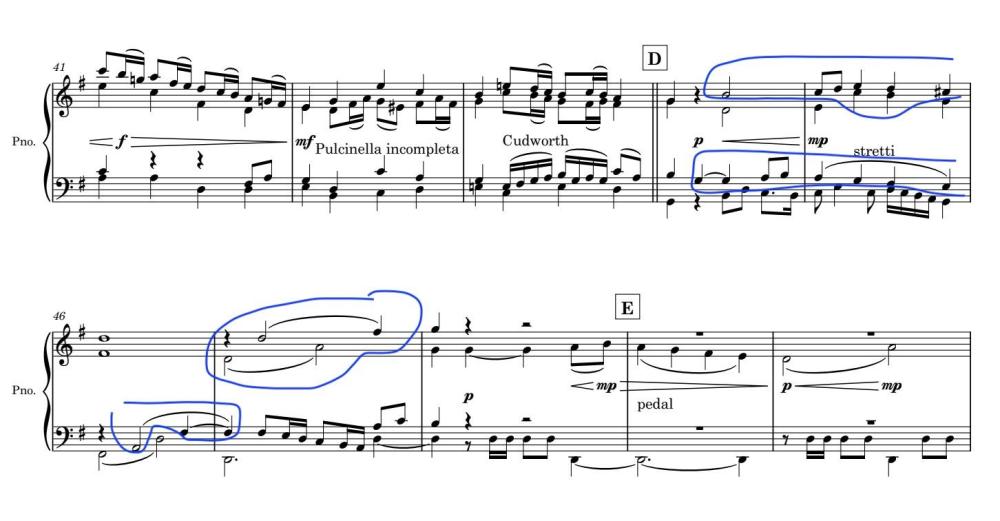Leaderboard
Popular Content
Showing content with the highest reputation on 07/24/2023 in all areas
-
Hi, I've been workin on this fugue, trying to apply my new knowledge. It's in G major, and there's controversy. In the subject the dominant note (D) appears quite clearly in measure 3. Is it supposed to be transposed tonally, i.e. a fourth up (G) instead of a fifth (A)? I didn't. As you can see in bar 8 it is as an A. It really is an ambiguous case "by the book". Since the D appears prominently but already in the third bar. So I tried to make the answer as you can see, and as it sounded good it stayed that way. The structure is: Exposition, where the 4 voices enter and the countersubject is written in invertible counterpoint. Divertimento, sequence or episode (measure 22) that modulates to the dominant (D). Counter-exposition (measure 26), using inverted subject and countersubject. Divertimento (m. 36) using Corelli's Leapfrog with the subject motive with other schemata and Cudworth cadence (which I like to use a lot). Stretti (m. 44) and mini-exposition with pedal note. Divertimento (m.58) in the subdominant area with plagal cadence and new Cudworth to return to the tonic. Coda (m 65) with perfect authentic cadence. As always happens to me, I'm sure I've missed parallels all over the place. But hey, someday I'll get closer....2 points
-
2 points
-
Kia Ora, Right of the bat, this a very lovely piece that you've written. A few caveats: The fast semiquaver alberti bass accompaniment get a bit boring about a minute into the piece. I would recommend in the future trying to vary the accompinament in order to sustain interest. I agree with Guardian, a contrasting section would really lift this piece up. Perhaps a slower, lyrical trio? Or a dancy bit? I would definitely start to add dynamics into your pieces. This piece would be really amplified if it had dynamics in it. All in all, a convincing and fun little piece. Nga Mihi, Arjuna2 points
-
Today I submit a recent work I premiered recently in a concert. This is a caprice with some influence from my origins in Ukraine but maybe not so obvious or exagerated but still in a simple way. It was composed in a short period of time the same day of the concert so this is primarily the reason of the simplicity and repetition. (I also attach a violin version of the score if you like it) Hope you like it! CapriccioViola.mp3 CapriccioViola.pdf1 point
-
I'm going to try another series on my YouTube channel (don't forget to subscribe btw). The series will be challenges, which is why I will start posting them here if this works out. But the challenges will have a twist. In this case, you will be presented in a YouTube video if you participate. This specific challenge would revolve around melody writing. And there can be multiple challenges of the same topic depending on popularity. The premise of this challenge: What makes a good melody? This is something that is not easy to answer. There doesn't seem to be a good formula, despite people trying to do so on YouTube. So what is this challenge? Submit an existing piece you feel is melodic (You can compose one too, but this isn't meant to be a competition, and I don't want to sit on this for months...a week or two at most). You can link your piece you wish to submit in this thread. And what I will attempt to do is point out your melody or melodies on camera. I'll try to explain what makes them good melodies. And the challenge is...can I point out the melody correctly? What this challenge will do is a few things Put me on the spot, but put the composer on the spot as well. Did your music convey the melody so that a listener (me in this case) could point it out correctly? Did you captivate an audience? Think of me as a smaller sample set of a larger sample. Real world examples of melodic writing from "today's composers" (either amateur, non established or established, it doesn't matter) can help other people see how to accomplish writing melodies. No formulas, no tricks, just real world examples and what makes them melodies. I feel that this challenge will be more effective with "today" composers. Composers of the past can work, but people may be like "yeah yeah, it's Bach, or Beethoven, what else is new". This will be the first interactive video I would create. Who knows how it will do but who wants to give it a shot? I'll close this thread after I feel there are enough submissions. If I get no submissions, I will attempt to do this with passed on composers. But I also risk copyright strikes. It's tough running a music channel! Participants @expert21 @Henry Ng Tsz Kiu @Camfrtt @AehrasYT @Zeldz1 point
-
Here a 12 tone idea that came up with. 12 tone music isn't something that I really study or write much of, but I made this idea for fun. I might extend this idea further or maybe write other short 12 tone pieces (Vignettes) as a sort of 12 tone collection for string quartet. Any feedback on this is welcomed! I tried to realize this on musescore, but some of the dynamics did not come out the way I wanted to, so it's not as balanced as I would like.1 point
-
@Henry Ng Tsz Kiu I agree, the "divertimento" part from b. 22 sounds a bit jazzy, but I don't dislike it there. It's based on a Mozart progression (in a string quartet of those dedicated to Haydn). When I made the subject, as already mentioned, I didn't think about the stretto, so it was difficult to fit only one superimposed entry: I always have a lot of animals, although in the last year and a half three of them have died of old age. Now I have two cats and three dogs. They have always lived together.1 point
-
Hi Luis, I like that your counterpoint has some modern touch in it as always, and I like how you use alternating textures of polyophony and homophony while using the same subject (I did something similar too haha I think in the Fugal 3rd movement of my Quintet so I like yours!). I actually find b.22 quite modern and funny with the tone clash even though it's Corelli's Leapfrog! Actually I don't see why b.44 is a stretti since I only find one subject appearance there, but maybe I'm muddle-headed this time??🤑🤑 Haha that's a war of battle all over at least for me as I can always find parallels in my own fugal writing. P.S I thought you're a dog person! But lovely cat anyways! Thx for sharing! Henry1 point
-
Hey Aaron, I am happy that you're trying the minor key and also developing your material! I have lots of observations and hope you don't find me nitpicky! 🙂 -B.5 (and similar places) maybe a B-C semiquaver instead of a C quaver will imply the dominant chord more clearly. -I love your modulation to C major in the first section, clearly you have taken @chopin's advice in your last post! -I think the caesura in b.20 slightly weird in that place, since it stops the flow suddenly and it's not cadential at all. Maybe you can just have the semiquaver flow keeps going, or have a half cadence there. -The LH figuration in b.22-23 can be counted as parallel fifth. You can have the first chord of b.23 in ii6 (D minor first inversion) first to prevent it. -B.33 can be in V/of C and it allows the harmony to go smoother will a V/G after it. -B.39 maybe you miss the F# for the first F in RH? -I think maybe you miss the F# for b.43-44? It results in a clash of F natural and F#. -I think in b.51 you can add D# to the Ds to imply the dominant of E minor which follows it. -B.53 and 56-59 the RH part can be written on a treble clef as the notes aren't really that low to be in bass clef. -For b.58 you can have C# and D# for a chromatic minor ascending scale for the RH melody. -In b.60 adding G#s to the G naturals will help us identify the dominant of A minor follows it! Also there's a parallel 5th with the G-B-D chord and A-C-E chord after it. Changing the first chord to G#-B-E will help! -Using the ascending melodic minor scale in b.70-71. that is adding a F# to it may help the melody sounds more melodious! -For the last bar if you write a D for top note, it should be resolved to a C for a ^4-^3 progression. Or you can use E-G#-B there for a firmer ending. I also agree with what @Guardian25 and Arjuna @expert21 have said. Thx for sharing your piece! Henry1 point
-
Perhaps either Valse Papillon or La Zattera?1 point
-
Thanks @Henry Ng Tsz Kiu. I'll choose and surprise you.1 point
-
I like the tonal colors that you got in this piece! The pizzicato part really helps with the "driving" rhythm in the piece! The violin part around 30 seconds reminds me of a melody from somewhere, but I can't remember where! Overall I really like it! Its short but it says a lot and has great energy throughout!1 point
-
Im really liking the overall sound of this piece! I think your overall harmonic construction for this piece sounds really great throughout and I like the melodies that you wrote over the accompaniment. I think one thing that this piece could benefit from would be a contrasting section! Maybe a slower section to contrast to the fast part throughout. Something with a different texture to the left hand ostinanto and fast right hand texture. But overall I think this piece sounds good and I really like the energy of it! Very classical in feel! Thanks for sharing!1 point
-
This piece sounds quite modern and dynamic, it's like from a movie. Apart from the rhythm itself which is powerful without being annoying, there are many techniques that make it so, such as pizzicato, tremolando and combinations of all.1 point





